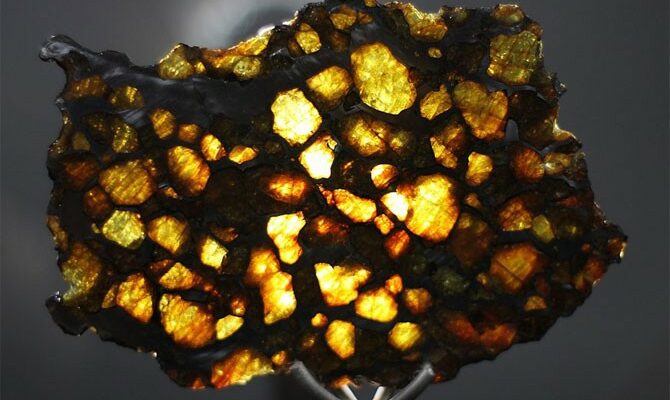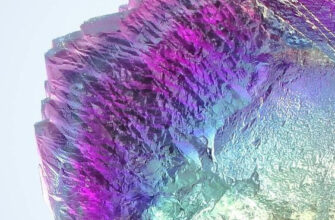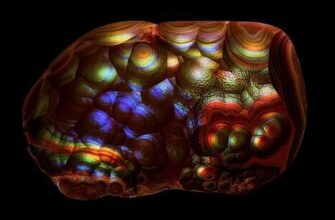Pallasite is a stone of extraterrestrial origin. This is a guest who flew to us from outer space, whose secrets people will not be able to fully understand even after thousands of years of scientific progress. Humanity knows hundreds of minerals that our planet is rich in. Each of the gems is unique, even if they are part of one large family. The common feature that unites each nugget is the cradle of life represented by planet Earth.
History and origin
Pallasites represent one of two classes of stony-iron meteorites. According to scientists' research, such meteorites are contemporaries of the formation of the planets of the solar system, formed from the fragments of colliding celestial bodies. The average age of pallasites is determined to be 4,5 billion years.
The study of the cosmic body began only 23 years later. In 1772, an expedition of a German scientist who was in Russian service, Peter Simon Pallas, took place on the lands of the Krasnoyarsk Territory. Following a written notification from Mettich, who described in detail what he saw, the academician inspected the mountain on which the stone was found. In 1773, a block weighing 40 pounds (the total weight of the meteorite was 42 pounds or 687 kg), by order of Pallas, was taken from the blacksmith’s yard, where it had been located all this time, to St. Petersburg for study. The stone was described as native iron. In 1777, the sample under study was moved to the Kunstkamera.
This is interesting! In 1794, the book of the German physicist and meteorite researcher Ernest Florence Friedrich Chladni, “On the Found Iron Mass, on Other Similar Masses, and on Certain Natural Phenomena Associated with It,” was published. This work became the first scientific substantiation of the extraterrestrial origin of the find, laying the foundation for the development of meteoritics - the science of meteorites, as well as cosmic dust that reaches planet Earth. Ernest Chladni named the meteorite “Pallas Iron” in honor of the academician who studied the find, after which the term “pallasite” was applied to all stony iron meteorites of this class.
Beginning in 1976, for three years of the expedition of A.I. Eremeeva determined the exact coordinates of the fall of the cosmic body. This is the right bank of the Krasnoyarsk reservoir, 4,5 km southeast of Bolshoi Emir Mountain.
Mining sites
Russian Siberia is rich in specimens of pallasite. It was there that the first pallasite was found. In addition, the Magadan region is famous for its finds. Large blocks were found in China and the USA. Sweden, Argentina, the Atacama Desert and even Antarctica are rich in rocks from space. Often pallasites are found completely by accident, regardless of archaeological or paleontological excavations, for example, during construction or work to strengthen the banks. In total, 55 specimens of pallasite have been found on Earth in different parts of the planet.
physical properties
The basis of pallasites is iron and nickel, which make up a kind of network that contains the silicate component of the meteorite - olivine crystals. The cosmic mineral is transparent and consists of magnesium, iron and silicon. But it was not possible to create such an alloy under terrestrial conditions.
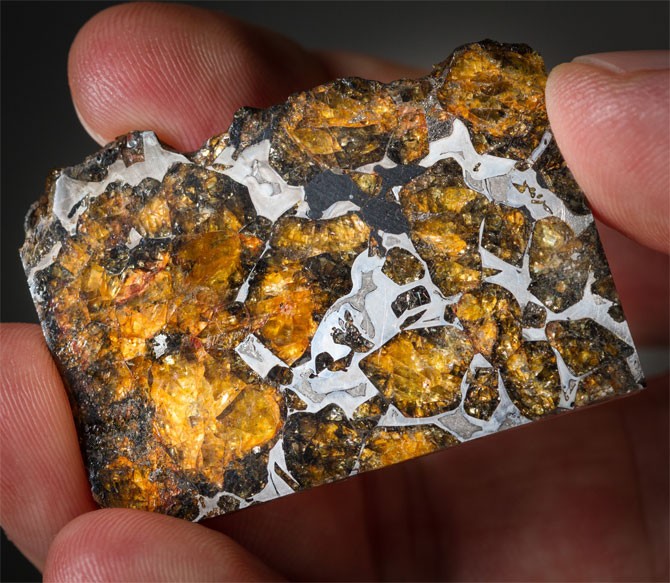
Composition:
- Metals - iron (80-90%),
- Nickel (3-20%),
- Olivine inclusions.
The parent body of pallasites is differentiated asteroids. If iron meteorites originate deep in the asteroid core, then iron-stone bodies are part of its inner coating - the place where metal and the silicate crust of the asteroid are mixed. Pyroxene pallasites stand apart - meteorites, the iron-nickel network of which includes not only olivine, but also pyroxene crystals. The mystery of the origin of such meteorites has not yet been revealed.
Famous representatives of the Pallasites
The end of the 19th and beginning of the 20th centuries was marked by two impressive finds of pallasites. One of the stones is considered the property of Russia.
Fukan
In 2000, an American tourist traveling through Chinese lands discovered an extraterrestrial nugget that weighed more than a ton. He sent the sawed-off fragment of the mineral home. Research has shown that this stone originated on an ancient planet, and its age is comparable to the age of the Earth. The peculiarity of the Chinese specimen is its fairly large olivine crystals, constituting 50% of the total mass of the meteorite.
Today, almost half of the stone is owned by the Natural History Museum of America. A small part of the celestial body (31 kg) is stored at the Arizona State University Meteorite Laboratory. This pallasite bears the name of the Chinese city of the same name where it was discovered - Fukan.
Seimchan
Since 2009, the Seymchan meteorite has been classified as a pallasite. The first part of this extraterrestrial body was discovered by geologist F.A. Mednikov during an expedition in the summer of 1967. A triangular conglomerate weighing 272 kg is located among stones on the bank of the Yasachnaya River bed (Magadan region, near the village of Seymchan). Three months later, in October of the same year, mine detector I.Kh. Markov came across a second sample, weighing 51 kg. The specimen was located only 20 meters from the site of the first discovery.
This is interesting! Some Seymchan samples are notable for the presence of Widmanstätten patterns, better known as Thomson structures. These are figured patterns formed by long nickel-iron crystals. The bent outlines of the figures indicate that during its entry into the Earth's atmosphere, the meteorite was subjected to strong resistance, which caused a shift and destruction of the celestial body into pieces.
The last expedition was led by geologist and meteorite enthusiast Dmitry Kachalin in 2004. Thus, another 50 kg of new samples were found, of which 10 kg contained olivine crystals. Thanks to new finds, the Seymchan meteorite was classified as a pallasite, although previously it was not possible to detect the silicate nature of the samples, and the meteorite was considered an octahedrite.
Applications
The heterogeneous structure of pallasite causes different values of its individual parts. Found meteorites are used for the following purposes:
- Scientific research.
- Jewelry processing.
- Crafts.
- Collectibles.
Pallasite is of greatest value for science. The study of cosmic bodies makes it possible to expand knowledge about the origin of our planet and the entire solar system as a whole.
Pallasite is successfully used by craftsmen to create decorative items, cases and boxes for storing jewelry. Jewelers are interested in the mineralogical part of the meteorite – olivine. Freed from metal inclusions, the faceted stone looks amazing in jewelry.
Rarity hunters love pallasite just as much as scientists or jewelers. Specimens found on all continents of the planet make up an impressive collection that can please the eye or bring a decent fortune.
Stone types
Depending on the chemical composition, pallasites are divided into three groups:
- The core group makes up the majority of the specimens found and is notable for its similarity to some iron meteorites, suggesting a common formation. Nickel content ranges from 8-12%.
- “Eagle” pallasites are similar to iron meteorites of another group, containing from 14 to 16% nickel.
- Pyroxene pallasites are unique meteorites that contain pyroxene crystals together with olivine.
The Seymchan meteorite is considered an anomalous pallasite, as it contains a large amount of iridium. In addition, not all fragments of this celestial body include olivine crystals.
Healing and magical properties
Stories spanning decades tell of both the beneficial and harmful effects of meteorite rocks. According to some reports, space guests cause internal discomfort or headaches. Other stories talk about the use of pallasites to treat skin diseases - purulent wounds, bedsores, warts, birthmarks, erysipelas. In addition, water or herbal decoctions were infused on meteorites, which were given to mothers and children. According to legends, such a ritual prolongs life. From a scientific point of view, the healing abilities of iron and iron-stone meteorites are explained by the presence of a magnetic field that helps a person overcome ailments.
Parapsychologists consider meteorites to be an activator of human paranormal abilities. Heavenly stones are also credited with the properties of a talisman against misfortune. For women, a pendant with a cosmic nugget will protect against celibacy, and any meteorite pebble is considered a magnet for attracting the opposite sex.
Jewelry with stone
Jewelry made from meteorites constitute a separate group of products from jewelry houses. The price for such accessories is not astronomical, but also not publicly available:
- Pendant in 925 silver with a polished triangular sample of the Seymchan meteorite.

- Silver earrings made from a single piece of the Seymchan meteorite.
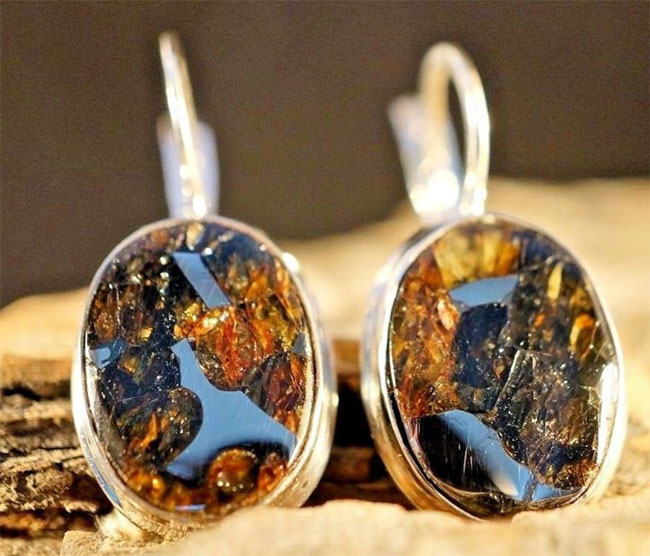
Costume jewelry has a lower price than products made from precious metals.
How to distinguish a fake
Pallasite is a stony-iron meteorite, which means its first distinguishing property will be the presence of a magnetic field. This can be determined using a magnet brought to the fragment. In addition, when passing through the earth's atmosphere, the edges of meteorites or their fragments melt, and on the very surface of the space rock there are characteristic dents, similar to fingerprints or burst bubbles.
Some pallasites (Seymchan) are endowed with Widmanstätten patterns, which cannot be recreated under terrestrial conditions. They also have not yet learned how to smelt cosmic olivine. In addition, any purchased meteorite or jewelry made from it must be supplied with an appropriate geological document confirming its cosmic origin and authenticity.
How to wear and care
Products made from meteorite iron were worn by the ancient Egyptians. Modern products are distinguished by their brevity. Each of the jewelry will be one of a kind, which will already make the image unique. The variety of designs allows you to wear pallasite accessories with any style of clothing, from a casual business suit to an evening outfit.
A stone that has traveled billions of space kilometers does not require special care. However, specimens with olivine require careful handling. Such samples are stored separately, from time to time cleaning the stones under running warm water.
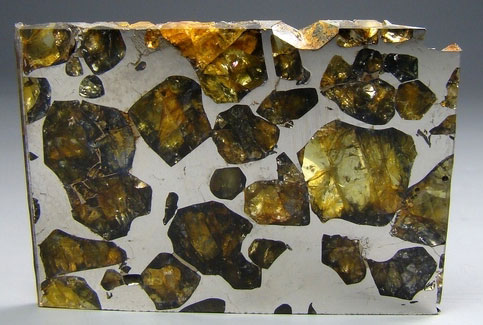
Interesting Facts
- The largest pallasite was found in the United States in 1882. The international name of the stone is Brenham. The giant space guest weighs 4,3 tons.
- In 2002, pallasite weighing 227 kg was discovered on Belarusian lands (Gomel region). The extraterrestrial alien lay at a depth of three meters, so the discovery was accidental. The stone was discovered by builders while digging a pit.
- Another remarkable pallasite weighing 1,5 tons was found on an Australian cattle farm in 1937.
- In honor of academician P.S. Pallas in the 1990th century founded the city of Pallasovka, which belongs to the Volgograd region. In 200, another sample of pallasite was found in this area, weighing almost XNUMX kg.
- Omolon is considered the oldest pallasite. Its age is estimated by scientists at 5,7 billion years. This cosmic miracle is the pride of Kolyma and is kept in the Natural History Museum of Magadan.
